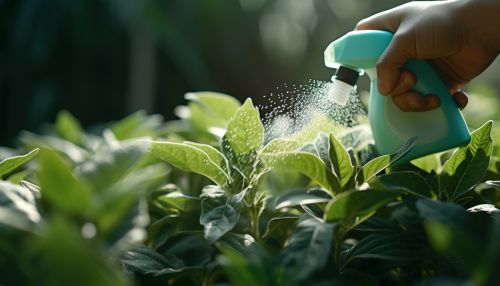Contact insecticide
Overview
Contact insecticides are a type of insecticide that kill insects upon direct contact. They are used in a variety of settings, including agricultural, residential, and commercial environments. Contact insecticides can be organic or synthetic, and they come in many different forms, such as sprays, dusts, and granules.


History
The use of contact insecticides dates back to ancient times. Early civilizations used natural substances with insecticidal properties to protect their crops and livestock from pests. The first synthetic contact insecticides were developed in the late 19th and early 20th centuries, with the introduction of compounds such as Dichlorodiphenyltrichloroethane (DDT) and organophosphates.
Types
There are several types of contact insecticides, each with its own unique properties and uses. These include:
- Organochlorines: These are synthetic insecticides that were widely used in the mid-20th century. DDT is the most well-known organochlorine insecticide.
- Organophosphates: These are a group of synthetic insecticides that interfere with the nervous system of insects. They are highly toxic and are used in a variety of settings, from agriculture to home pest control.
- Pyrethroids: These are synthetic insecticides that are modeled after the natural insecticides found in chrysanthemum flowers. They are less toxic to mammals and birds than other types of insecticides, making them a popular choice for residential and commercial use.
- Neonicotinoids: These are a newer class of synthetic insecticides that affect the central nervous system of insects. They are commonly used in agriculture, particularly in seed treatments.
Mode of Action
Contact insecticides work by coming into direct contact with the insect. They can affect the insect in a variety of ways, depending on the specific type of insecticide. Some contact insecticides interfere with the insect's nervous system, causing paralysis and death. Others may affect the insect's respiratory system or disrupt its growth and development.
Environmental Impact
The use of contact insecticides can have significant environmental impacts. These chemicals can persist in the environment for long periods of time, leading to contamination of soil and water. They can also have non-target effects, killing beneficial insects and other organisms. The use of contact insecticides has been linked to declines in bee populations, a phenomenon known as colony collapse disorder.
Health Effects
Exposure to contact insecticides can pose health risks to humans and other animals. These risks can vary depending on the specific type of insecticide, the amount of exposure, and the individual's health status. Symptoms of exposure can range from mild irritation to severe neurological effects. Some contact insecticides have been linked to cancer and other long-term health effects.
Regulation
Contact insecticides are regulated by various government agencies around the world. In the United States, the Environmental Protection Agency (EPA) is responsible for regulating the use and disposal of these chemicals. Regulations may include restrictions on use, labeling requirements, and disposal guidelines.
